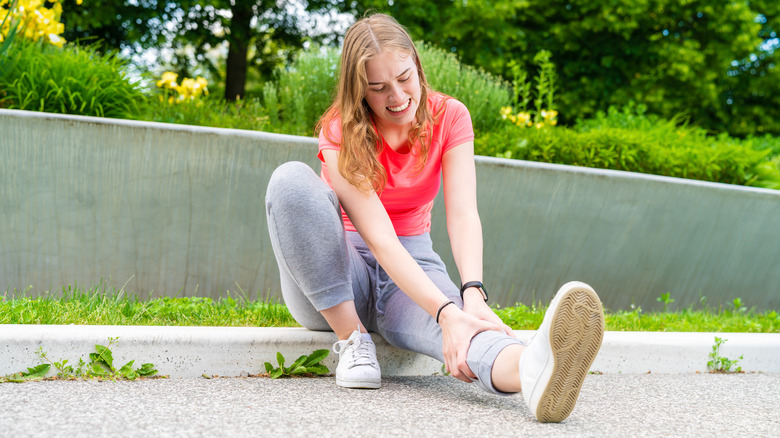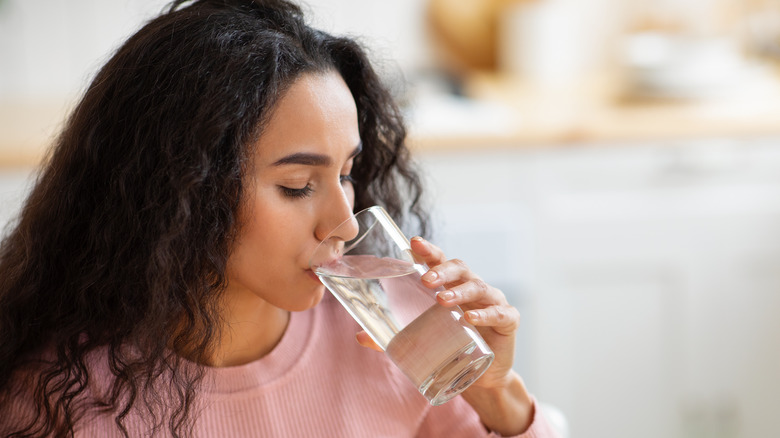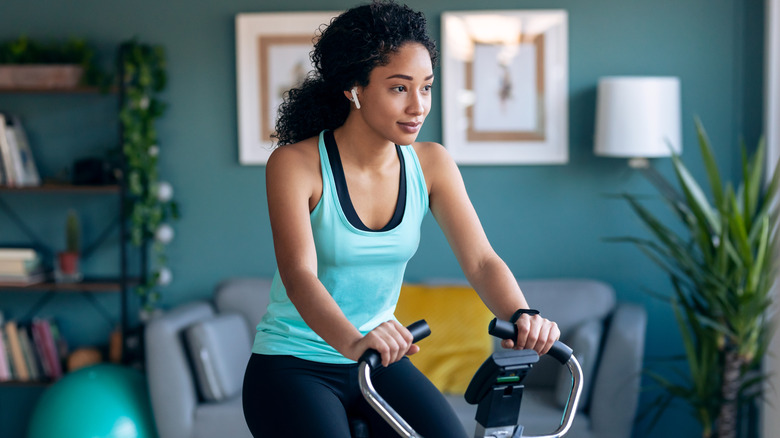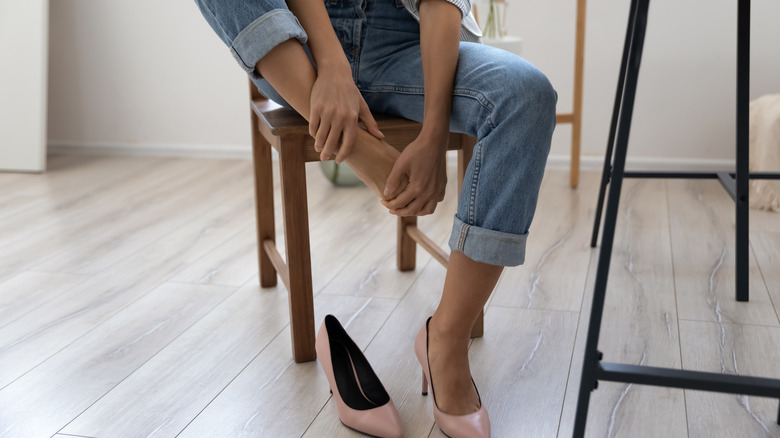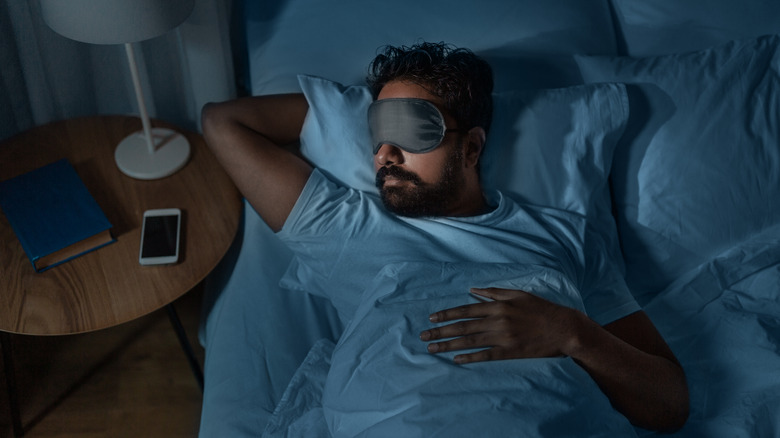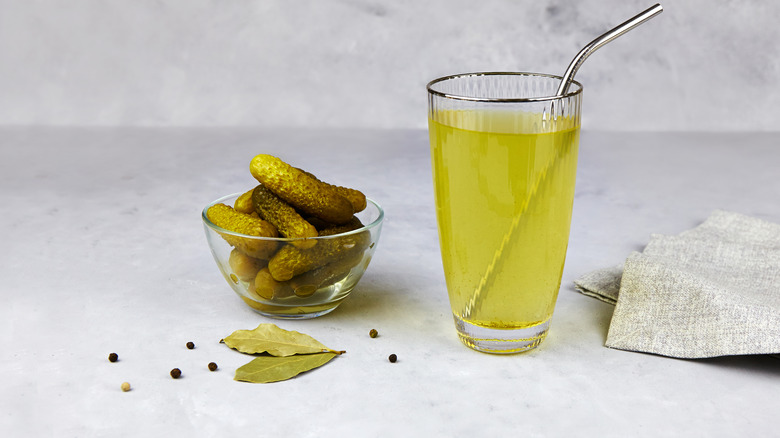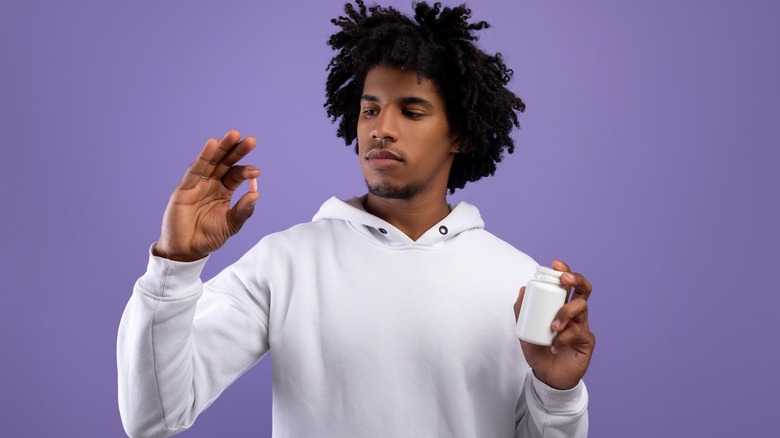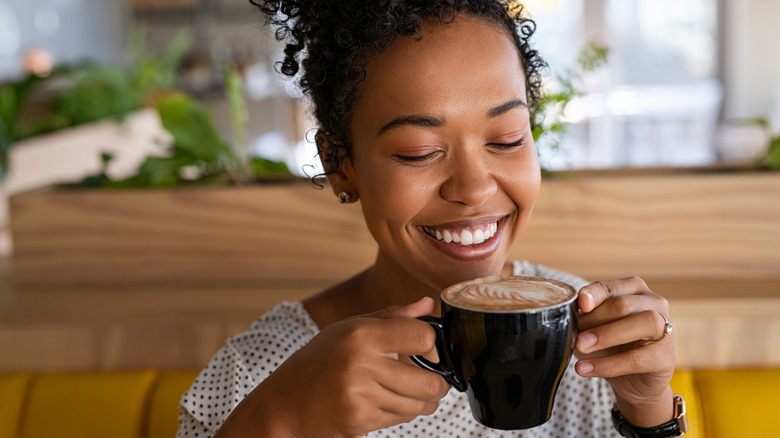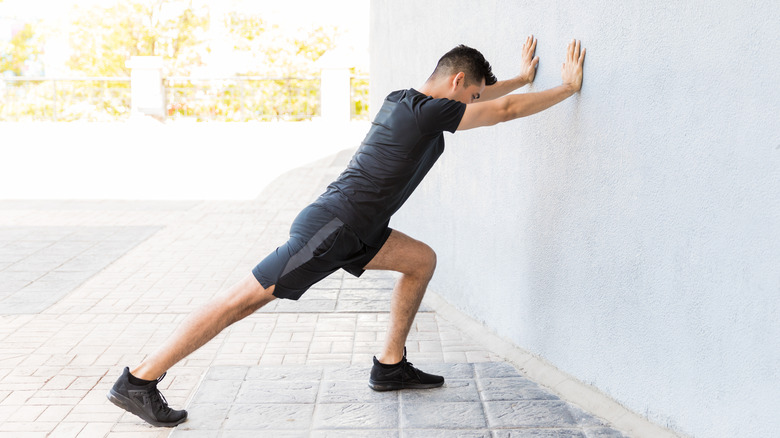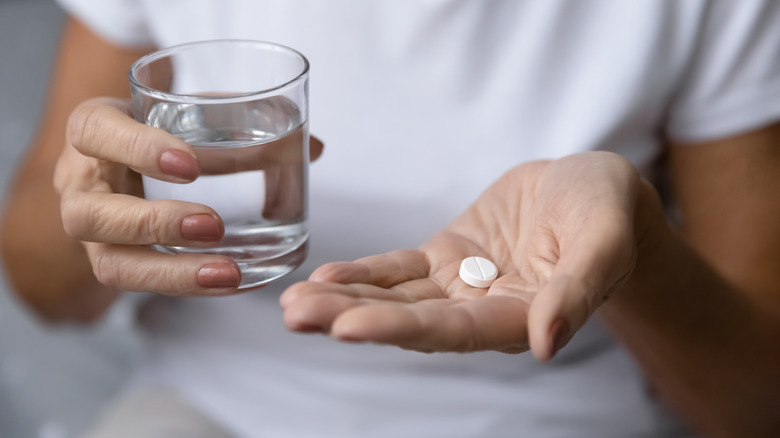How To Get Rid Of Charley Horses
No one wants to experience a muscle cramp. The awful pain that comes with a charley horse will definitely leave its sufferers looking for a quick and easy form of relief. According to Medical News Today, a charley horse is a muscle cramp that can suddenly pop up without warning. Nevertheless, the painful cramps most typically occur during exercise or at night. While the cramp isn't limited to a specific area of the body, a charley horse usually occurs in the calf muscle. However, a charley horse can also affect your foot or even your thigh muscles.
Naturally, experiencing this type of unwanted and uncontrollable discomfort would leave anyone looking for a cure. While doctors still aren't sure why some people experience this type of muscle cramp, some of the suspected causes include overexertion during exercise and dehydration. Preventative measures and treatments vary, but there are plenty of simple practices that could potentially make a difference when it comes to these annoying cramps. With a variety of approaches from which to choose, those looking to get rid of a painful charley horse may be eager to try out these methods in search of some much-needed relief.
Focus on prevention by staying hydrated
No one likes muscle cramps, and the ones that wake you up in the middle of the night are even worse. Still, instead of waiting to treat the pain after it starts, you can try preventing a charley horse with a super-easy practice that anyone can incorporate into their day: drinking more water. According to the Cleveland Clinic, dehydration is a major culprit when it comes to the varying causes of leg (and overall muscle) cramps.
ScienceDaily, however, reports that a 2021 study found that consuming electrolytes is even more beneficial for combating a charley horse than water alone. According to lead researcher Professor Ken Nosaka, plain water while exercising may actually make you more susceptible to getting cramps. "This is likely because pure water dilutes the electrolyte concentration in our bodies and doesn't replace what is lost during sweating," Nosaka said. Nosaka added that electrolytes (which contain minerals like sodium, potassium, magnesium, and chloride and are essential for maintaining a healthy body) are beneficial to everyone. Those looking to incorporate electrolytes into their diet can get their fix through foods like chicken or drinks like coconut water (via Insider). You can also buy electrolyte-infused water.
Try some light exercise before bed
If you're dreading the possibility of experiencing a charley horse in the middle of the night, you can always try getting in some light exercise before bed. According to the Mayo Clinic, light activity before drifting off to dreamland can potentially keep nighttime muscle cramps at bay. However, those looking to try this preventative practice should also remember that a moderate or intense workout may negatively affect a person's sleep. Therefore, it is essential to keep any pre-bed activity low-key and make sure to space out your activity in order to avoid any possible negative reactions.
Such activities may include jogging in place, riding a stationary bike, or gently walking a set of stairs. All of these activities can be beneficial in preventing nighttime cramps. Women's Running adds that those already engaging in significant activity should be mindful about not overexerting their bodies and remember that prevention — rather than treatment — is ideal when it comes to treating a charley horse.
Try applying heat and ice to the affected area
If you've tried preventing the ever-dreaded charley horse and have still found yourself on the receiving end of this painful type of cramp, there are some measures you can take in order to relieve some of your discomfort. According to WebMD, one of the treatments that can potentially soothe this painful cramp is applying heat followed by ice to the affected area. In order to try this remedy, you'll first want to choose your heating source. The health outlet says that you can try a warm bath or shower or use a heating pad or warm towel directly applied to the affected area. For the second step, you can utilize a cold pack or a bag of ice applied to the cramped muscle. Those taking advantage of the cold method should never place ice directly on the skin, but instead, wrap it up in a towel or something similar.
Give your feet the proper support
While plenty of people are willing to deal with a bit of discomfort in order to show off a stunning pair of shoes, the consequences of cramped footwear can linger long after you take them off your feet. According to SheKnows, high heels can definitely be a culprit when it comes to lower leg and foot issues due to the way heels shift a portion of your body weight to your toes. This unnatural position can lead your body to compensate by tightening up other muscles — which can, in turn, create an environment for a charley horse.
However, if you can't imagine giving up your fabulous footwear, the outlet did offer up some suggestions. For example, you can try wearing a lower or thicker heel, and you can also incorporate some quick and easy leg stretches (such as a calf stretch) to avoid experiencing muscle cramps. But of course, it isn't just heels that can leave you with painful muscle cramps. Healthline notes that any ill-fitting footwear that may lack support can lead to issues with your foot muscles, and the same goes for standing or working on a hard surface for long periods of time. Essentially, if you're restricting the circulation in your feet in any way, you're potentially preventing proper blood flow, which can, unfortunately, lead to pain even while lying down.
Certain foods can help with muscle cramps
Outside of physical activity and hydration, another daily preventative measure that can potentially prevent irritating leg cramps is healthy eating. According to Healthline, there is some research that supports the idea that eating certain high-nutrient foods may possibly lessen muscle cramps and even prevent them from happening at all. The first recommendation is the ever-popular avocado, which provides the body with plenty of potassium and magnesium — two minerals that are crucial for healthy muscles. Papaya is high in these minerals as well. The ultra-hydrating watermelon is a third fruit that can potentially keep a charley horse at bay.
In addition to these fruits, you can also try preventing muscle cramps with some sweet potatoes or beet greens, the latter of which is packed with potassium and magnesium as well as calcium, phosphorus, and a variety of B vitamins. Other muscle-friendly foods include Greek yogurt and protein-packed salmon. If you'd prefer to incorporate more liquids into your diet, you can also try sipping on a homemade smoothie, or if you have the patience to wait at least eight hours, attempt to make your own ultra-trendy and nutrient-rich bone broth.
Keep your sheets and blankets loose
Preventing painful nighttime leg cramps isn't just about what you put in your body or what you're wearing on your feet. According to AARP, the way you sleep can also be a contributing factor when it comes to experiencing a charley horse. The organization says that your position in bed and some tightly tucked covers can actually aggravate your muscles to the point of causing cramps. As a preventative measure, the outlet recommends lying down on your side with bent knees along with keeping your blankets and sheets loose.
Similarly, Healthline notes that making sure your feet aren't pointing downward in bed is a crucial tip for preventing night cramps. The site also suggests avoiding any type of thick or heavy bedding that could change your position or inhibit your movement during sleep hours. The article adds that you can also try placing a pillow underneath your knees for uninterrupted snoozing and extra support. Such changes may help ease unwanted irritation in your calf muscles.
Try drinking pickle juice
If you still find yourself suffering from a dreaded charley horse even after trying other natural remedies and lifestyle changes, you can always try drinking pickle juice. A 2010 study published in the National Library of Medicine concluded that drinking a small serving of pickle juice about 35 seconds after the onset of a leg cramp reduced the pain quicker than those who drank only water. But why pickle juice? Brooks College of Health instructor Nicole Nelson told Men's Health that while some people think that the sodium in the liquid is responsible, it's not actually possible for the body to absorb it that fast. Instead, Nelson explained that the pickle juice is likely setting off an automatic response in your throat that leads to physical relief, as it may help to reduce neurons responsible for promoting muscle cramps.
Healthline suggests that those curious to try the pickle juice remedy drink about a single shot's worth of straight store-bought or homemade pickle juice.
Try taking supplements
If you want to incorporate preventative measures into your routine but aren't interested in changing your diet, you can always try taking supplements instead. According to Healthline, magnesium is frequently taken as a home remedy for leg cramps. The report adds that magnesium supplements are relatively inexpensive and safe to take when used as directed. How much magnesium you need depends on your sex and age, but according to the National Institutes of Health, those most likely to be deficient in this mineral are men over the age of 70 and teenagers.
Similarly, Chiropractic Economics states that supplementing your diet with Vitamin B complex and zinc can also be beneficial for muscle cramps as our bodies need various B vitamins to function properly. Therefore, in addition to providing energy, aiding digestion, and contributing to healthy hormone production, Vitamin B (and specifically Vitamin B complex) may potentially relieve muscle cramps as well. As for zinc, the informational source states that a 2000 study published in the National Library of Medicine found that zinc supplements were beneficial in providing relief for patients who suffered from weekly muscle cramps. It is best to consult your doctor or healthcare provider before starting any supplement regimens.
Reduce your caffeine and alcohol intake
While a hot cup of coffee might seem like the perfect morning pick-me-up, those who suffer from muscle cramps should probably think twice before reaching for a second or third steaming cup of java. The American Journal of Medicine notes, however, that consuming too much caffeine may be linked to increased susceptibility to muscle cramps. As a result, you may want to consider caffeine in moderation the next time you want to go on a Starbucks run.
Similarly, cocktail connoisseurs and fans of the late-night glass (or two) of wine definitely won't be thrilled to learn that happy hour isn't beneficial if you're dealing with muscle cramps. For example, MUSC Health reports that dehydration could lead to cramps and advises those trying to prevent them against consuming alcohol before bedtime. Still, if you find yourself indulging in a couple of nighttime drinks, remember to try and counteract the dehydration that can be caused by alcohol consumption.
Stretch it out
One simple method for dealing with a pesky charley horse requires almost nothing but some patience. The Cleveland Clinic states that taking the time to incorporate some simple stretches into your day is an easy way to combat muscle cramps. "You want your muscles to be as strong and supple as they can be," said sports medicine specialist Dr. Caitlin Lewis. "Adequate stretching after a brief warm-up period or after a shower is key to this."
Good Housekeeping also recommends three easy stretches that can be done at home. The first is a standing calf stretch that involves placing your palms on a wall with your arms extended, one leg bent at the knee, and the other leg straight back (don't forget to keep your feet firmly planted on the floor). Then, after leaning forward to allow the muscle to get a nice stretch, you'll want to alternate your leg and repeat the process.
The article's second suggestion is a standing hamstring stretch, which requires putting a chair against a wall, standing while facing it, and placing your heel on the chair with your leg straight. You'll then want to bend forward at the hips, keeping your upper body straight and your other foot on the floor before alternating sides. The final recommendation is the seated calf and hamstring stretch. To take advantage of this stretch, you'll want to sit on a firm surface with both legs extended, bend forward at the hips while keeping your back straight, and grab your toes or calves.
Try over-the-counter pain reducers
When the discomfort of a charley horse is simply too much to bear, you can always try taking an over-the-counter pain reducer. Healthline reports that nonsteroidal anti-inflammatory drugs (better known as NSAIDs) may possibly bring some much-needed relief when a muscle cramp turns from uncomfortable to painful. The Cleveland Clinic adds that ibuprofen (known by brand names Advil or Motrin) and acetaminophen (otherwise known as Tylenol) are two pain relievers that can be taken for charley horses.
Healthline also points out that in addition to oral pain relievers, you can try over-the-counter direct contact creams that contain lidocaine, camphor, or menthols, such as Biofreeze or Tiger Balm. Other topical pain relief suggestions include homeopathic gel products containing turmeric and celery seed, which can potentially soothe the pain and inflammation experienced during a muscle cramp. Still, the informational source remarks that if you're frequently experiencing muscle cramps, you might want to consider speaking with your doctor to rule out any possible conditions that could be causing the condition.
